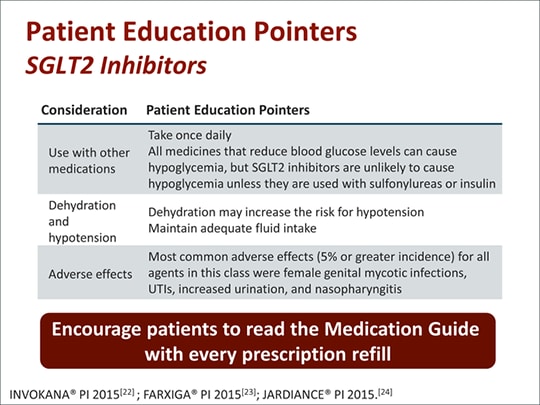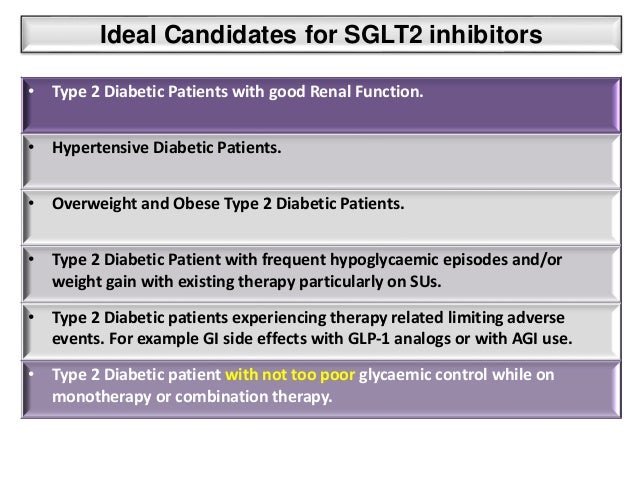Sglt2 inhibitors work by blocking the reabsorption of glucose in the proximal renal tubule, resulting in increased glucose excretion. Notably, these trials also disclosed nephroprotective effects when renal outcomes (glomerular filtration rate and albuminuria) were analyzed as secondary endpoints.

SGLT2 Inhibitors (Gliflozins) A New Class of Drugs to
Some of the side effects include:

Sglt2 inhibitors side effects. By removing glucose from the body, sglt2 inhibitors can also have benefits for weight loss. Sglt2 inhibitors promote glucose excretion in the urine by blocking the action of this protein. But they can also cause serious side effects including increased risk of amputations, diabetic ketoacidosis, and blood and kidney infections.
In addition, if you’re taking certain types of diuretics, sglt2 inhibitors can increase their effect, causing you to urinate more often. It’s also important to be aware that your urine will test positive for glucose if you take this medication. Sglt2 inhibitors, also called “gliflozins” inhibit sglt2 proteins located in the tubules of the kidneys, which are responsible for reabsorbing glucose back into the blood, resulting in high glucose levels in the blood.
However, like all medications, sglt2 inhibitors can cause side effects in some people and, very rarely, these can be serious. Sglt2 inhibitors are associated with a small increase in adverse effects related to intravascular volume depletion, such as hypotension, syncope and dehydration. With glucose and sodium, excess water is also lost.
The name of these drugs end with ‘gliflozin’. Higher risk of developing genital and urinary tract infections; Sglt2 inhibitor drugs are designed to be used in combination with diet and exercise to improve glycemic control in adults with type 2 diabetes, which, over time, can increase the risk for serious complications like blindness, heart disease, and nerve and kidney damage.
Adverse effects of sglt2 inhibitors. This mechanism is responsible for the rare but potentially serious adverse effect of utis and other genital infections. Sglt2 inhibitors can cause intravascular volume contraction and osmotic diuresis.
Invokana, farxiga, and jardiance are example of sglt2 inhibitors approved for use in the us. Taking sglt2 inhibitors with insulin, sulphonylureas or glinides may. Sglt2 inhibitors can reduce the blood sugar level by blocking reabsorption of glucose in the kidney and increasing glucose excretion.
Canagliflozin, dapagliflozin and empagliflozin belong to the class of sglt2 inhibitors. Food and drug administration also warns of more rare but serious issues such as amputations, kidney injury and ketoacidosis. If you take sglt2 tablets, you may experience some side effects.
Other symptoms individual drugs have been found to have a higher incidence of bladder cancer (dapagliflozin) and increase in hdl and ldl cholesterol (canagliflozin). However, the balance between positive and negative effects is in favor of the former. Side effects linked to sglt2 inhibitors.
Because of the osmotic diuresis induced by glycosuria resulting. The most serious side effect of sglt2 inhibitors is a greater chance that you could get diabetic ketoacidosis, a condition that happens when your body. 14 in euvolaemic patients consider reducing the dose of any diuretics to avoid further volume depletion.
Check the patient information leaflet (pil) that comes with your medication. They are growing in popularity because they are effective at lowering blood sugar. The use of sglt2 inhibitors in patients with kidney disease is becoming the standard of care.
What are sglt2 inhibitors side effects? Adverse effects of sglt2 inhibitors. Hypotension is a common side effect of sglt inhibitors:
As the drugs cause more glucose to be excreted in the urine, there is a higher chance of getting genital and urinary tract infections these side effects are more common in women than in men. As i discussed the mechanism of sglt2 inhibitors, these drugs excrete out the glucose through urine that causes the glucosuria effect (presence of sugar in. What other side effects do sglt2 inhibitors cause?
Common sense tells us that an increased presence of glucose in the urine provides a. This table covers many of the common potential side effects from several of the major clinical trials. Detectable concentrations of glucose in the urine can facilitate the onset of mycotic infections, as observed in patients who experience severe hyperglycemia with glycosuria.
Most people can take sglt2 inhibitors without experiencing many other side effects. Sglt2 inhibitors are relatively new and have several side effects that warrant caution, including the unique risks of diabetic ketoacidosis (dka), mycotic genital infections and possibly lower limb amputations. Common side effects of sglt2 inhibitors include yeast infections, urinary tract infections, and low blood sugar when combined with other prescription diabetes medicines.
Hypoglycemia, the most common side effect of antidiabetic agents, is fairly uncommon with sglt2 inhibitors given as monotherapy. Sglt2 inhibitors should be withheld when a patient is at risk of dehydration, such as during an. If you think you may be experiencing any of the side effects, speak to your gp straight away.
SGLT2 Inhibitors in the Modern Era Weighing Risk vs

SGLT2 Inhibitors A New Class in Diabetes Treatment

Do Sglt2 Inhibitors Cause Hypoglycemia

Improving with SGLT2 Cotransporter Inhibitors in

SGLT2 Inhibitors Pharmacology Summary Mechanisms

Potential Adverse Effects of SGLT2 Inhibitors in Clinical

Dpp4i vs sglt2 inhibitors against the motion

A Primary Care Perspective on SGLT2 Inhibitors (Transcript)

Khanh's blog [CẢNH GIÁC DƯỢC] CANAGLIFLOZIN
